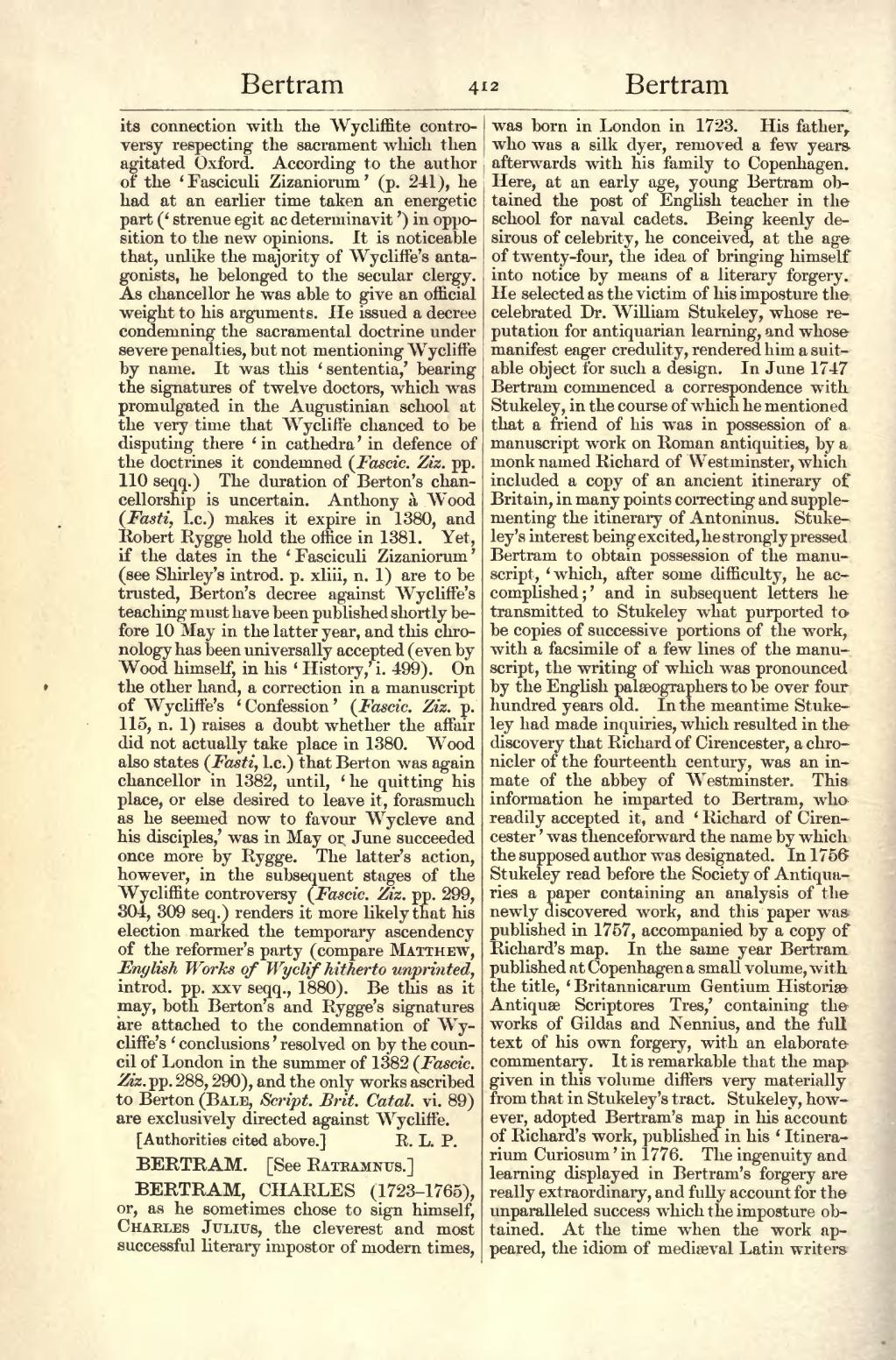its connection with the Wycliffite controversy respecting the sacrament which then agitated Oxford. According to the author of the 'Fasciculi Zizaniorum' (p. 241), he had at an earlier time taken an energetic part ('strenue egit ac determinavit') in opposition to the new opinions. It is noticeable that, unlike the majority of Wycliffe's antagonists, he belonged to the secular clergy. As chancellor he was able to give an official weight to his arguments. He issued a decree condemning the sacramental doctrine under severe penalties, but not mentioning Wycliffe by name. It was this 'sententia,' bearing the signatures of twelve doctors, which was promulgated in the Augustinian school at 'the very time that Wycliffe chanced to be disputing there 'in cathedra' in defence of the doctrines it condemned (Fascic. Ziz. pp. 11O seqq.) The duration of Berton's chancellorship is uncertain, Anthony à Wood (Fasti, l.c.) makes it expire in 1380, and Robert Rygge hold the office in 1381. Yet, if the dates in the 'Fasciculi Zizaniorum' (see Shirley's introd. p. xliii, n. 1) are to be trusted, Berton's decree against Wycliffe's teaching must have been published before 10 May in the latter year, and this chronology has been universally accepted (even by Wood himself, in his 'History,' i. 499). On the other hand, a correction in a manuscript of Wyclitle's 'Confession' (Fascic. Ziz. p. 115, n. 1) raises a doubt whether the affair did not actually take place in 1380. Wood also states (Fasti. l.c.) that Berton was again chancellor in 1382, until, 'he quitting his place, or else desired to leave it, forasmuch as he seemed not to favour Wycleve and his diciples,' was on May of or June succeeded once more by Rygge. The latter's action, however, in the subsequent stages of the Wycliffe controversy (Fascic. Ziz. pp. 299, 304, 309 seq.) renders it more likely that his election marked the temporary ascendency of the reformer's party (compare Matthew, English Works of Wyvclif hitherto unprinted, introd. pp. xxv seqq., 1880). Be this as it may, both Berton's and Rygge's signatures are attached to the condemnation of Wycliffe's 'conclusions' resolved on by the council of London in the summer of 1382 (Fascic. Ziz. pp. 288, 290), and the only works ascribed to Berton (Bale, Script. Brit. Catal. vi. 89) are exclusively directed against Wyclille.
[Authorities cited above.]
BERTRAM, [see Ratamnus.]
BERTRAM, CHARLES (1723–1765), or, as he sometimes chose to sign himself, Charles Julius, the cleverest and most successful literary impostor of modern times, was born in London in 1723. His father who was a silk dyer, removed a few years afterwards with his family to Copenhagen. Here, at an early age, young Bertram obtained the post of English teacher in the school for naval cadets. Being keenly desirous of celebrity, he conceived at the of twenty-four, the idea of bringing himself into notice by means of a literary forgery. He selected as the victim of his imposture the celebrated Dr. William Stukeley, whose reputation for antiquarian learning, and manifest eager credulity, rendered him a suitable object for such a design. In June 174 Bertram commenced a correspondence with Stukeley, in the course of which he mentionted that a friend of his was in possession of manuscript work on Roman antiquities, by monk named Richard of Westminster, which included a copy of an ancient itinerary of Britain, in many points correcting and supplementing the itinerary of Antoninus. Stukeley's interest being excited, he strongly pressed Bertram to obtain possession of the manuscript, 'which, after some difficulty, he accomplished;' and in subsequent letters he transmitted to Stukeley what purported to be copies of successive portions of the work, with a facsimile of a few lines of the manuscript, the writing of which was pronounced by the English palaeographers to be over four hundred years old. In the meantime Stukeley had made inquiries, which resulted in the discovery that Richard of Cirencester, a chronicler of the fourteenth century, was an inmate of the abbey of Westminster. This information he imparted to Bertram, who readily accepted it, and 'Richard of Cirencester' was thenceforward the name by which the supposed author was designated. In 1756 Stukeley read before the Society of Antiquaries a paper containing an analysis of the newly discovered work, and this paper was published in 1757, accompanied by a copy of Richard's map. In the same year Bertram published at Copenhagen a small volume, with the title, 'Britannicarum Gentium Historiæ Antiquæ Scriptores Tres,' containing the works of Gildas and Nennius, and the full text of his own forgery, with an elaborate commentary. It is remarkable that the map given in this volume differs very materially from that in Stukeley's tract. Stukeley, however, adopted Bertram's map in his account of Richard's work, published in his 'Itinerarium Curiosum' in 1776. The ingenuity and learning displayed in Bertram's forgery are really extraordinary, and fully account for the unparalleled success which the imposture obtained. At the time when the work appeared, the idiom of mediæval Latin writers
